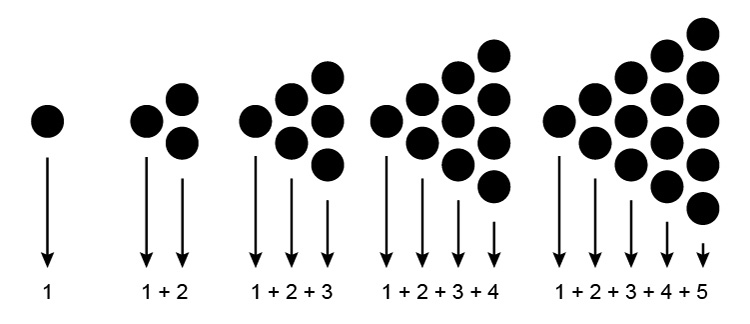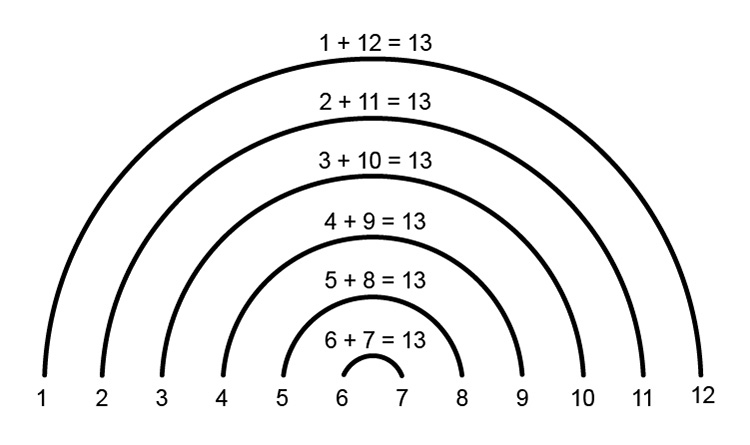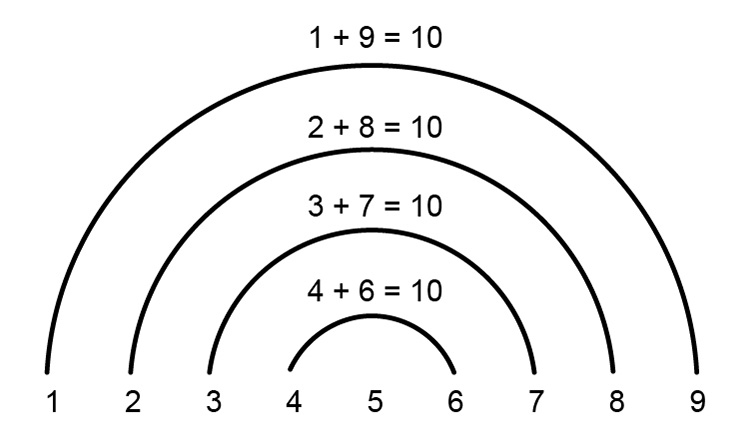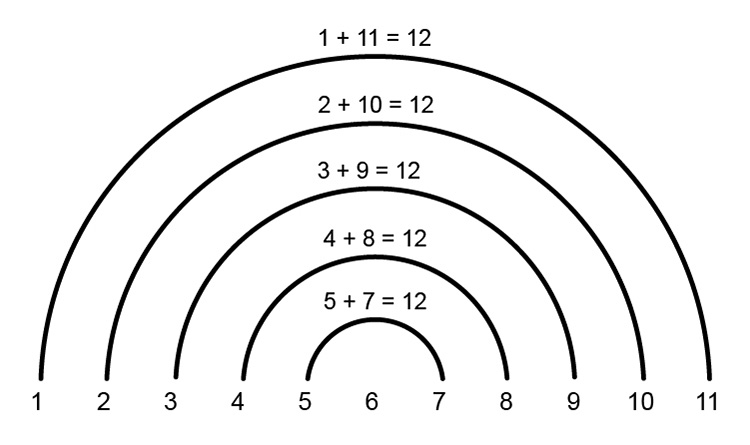Triangles and the `n^(th)` term
`1` `3` `6` `10` `15`
You can recognise a triangular sequence by picturing it as follows:

We can see a pattern emerge
| `1^(st)` | term `=1` | `=1` |
| `2^(nd)` | term `=1+2` | `=3` |
| `3^(rd)` | term `=1+2+3` | `=6` |
| `4^(th)` | term `=1+2+3+4` | `=10` |
| `5^(th)` | term `=1+2+3+4+5` | `=15` |
This also gives us a clue as to how we find the `n^(th)` term of any triangular sequence (But note the following only applies when the sequence starts at the number 1).
At first, just take one large even set of `n^(th)` terms
Try `12^(th)` term
The `12^(th)` term would be
`1+2+3+4+5+6+7+8+9+10+11+12=78`
But a mathematician found that if you started by adding the `1^(st)` and last term together and then continue this arrangement then a pattern emerges.
i.e.

| `12^(th)` term`=` | `1+12` | `=13` | |
| `2+11` | `=13` | ||
| `3+10` | `=13` | ||
| `4+9` | `=13` | ||
| `5+3` | `=13` | ||
| `6+7` | `=13` | ||
`6times13` |
`=78` |
So the pattern is `13` and the multiple is `6`.
This works for any even numbered triangular number.
Try `16^(th)` term
| `16^(th)` term`=` | `1+16` | `=17` | |
| `2+15` | `=17` | ||
| `3+14` | `=17` | ||
| `4+13` | `=17` | ||
| `5+12` | `=17` | ||
| `6+11` | `=17` | ||
| `7+10` | `=17` | ||
| `8+9` | `=17` | ||
`8times17` |
`=136` |
So the pattern is `17` and the multiple is `8`.
Now we can form a formula for this
Stage 1 find the pattern number
`12^(th)` term `=(12+1)=13`
`16^(th)` term `=(16+1)=17`
So the pattern number `=(n^(th)\ \n\u\m\b\e\r+1)`
Stage 2
And the amount of times we repeat this pattern number (the multiple)
`12^(th)` term `=(12)/2=6`
`16^(th)` term `=(16)/2=8`
So the multiple `=(n^(th)\ term)/2`
Put stage 1 and stage 2 together we get:
`(n^(th)\ term+1)times(n^(th)\ term)/2`
So the `n^(th)\ term=(n+1)timesn/2`
And amazingly this also works for odd triangular numbers too.
Example 1
What is the `9^(th)` term of the triangular sequence
Either draw it

| `9^(th)` term`=` | `1+9` | `=10` | |
| `2+8` | `=10` | ||
| `3+7` | `=10` | ||
| `4+6` | `=10` | ||
| `4times10` | `+5=45` |
NOTE:
We add `5` because that is the number missed in the series of semi-circles above.
or using the formula
`(n+1)timesn/2`
| `9^(th)` term | `=(9+1)times9/2` |
| `=(10times9)/2` | |
| `=5times9` | |
| `=45` |
Example 2
What is the `11^(th)` term of the triangular sequence
Either draw it

| `11^(th)` term`=` | `1+11` | `=12` | |
| `2+10` | `=12` | ||
| `3+9` | `=12` | ||
| `4+8` | `=12` | ||
| `5+7` | `=12` | ||
| `5times12` | `+6=66` |
NOTE:
We add `6` because that is the number missed in the series of semi-circles above.
or using the formula
`(n+1)timesn/2`
| `11^(th)` term | `=(11+1)times11/2` |
| `=(12times11)/2` | |
| `=6times11` | |
| `=66` |
Example 3
What is the `27^(th)` term of the triangular sequence
We are not going to draw this out but we can just rely on the formula.
`(n+1)timesn/2`
| `27^(th)` term | `=(27+1)times27/2` |
| `=(28times27)/2` | |
| `=14times27` | |
| `=378` |
Example 4
What is the `28^(th)` term of the triangular sequence
Again we are not going to draw this out but the formula gives:
`(n+1)timesn/2`
| `28^(th)` term | `=(28+1)times28/2` |
| `=(29times28)/2` | |
| `=29times14` | |
| `=406` |
(As a point of interest comparing example 3 and the answer 378 and here 406 the difference is 28 which would be correct.)




